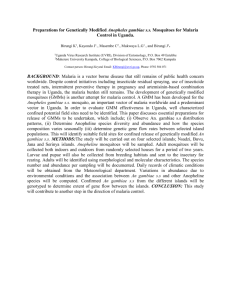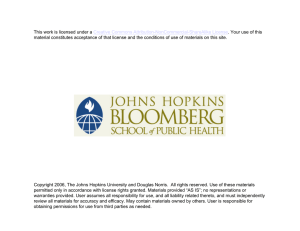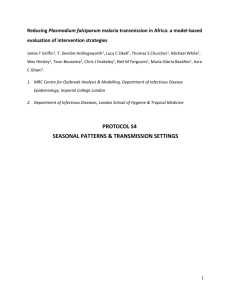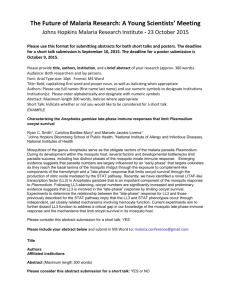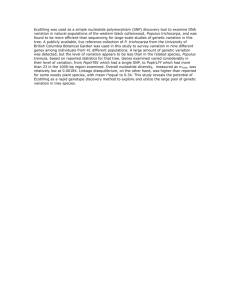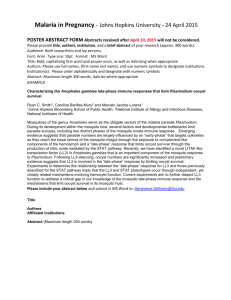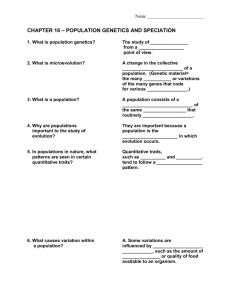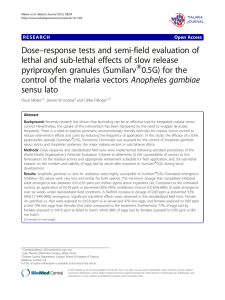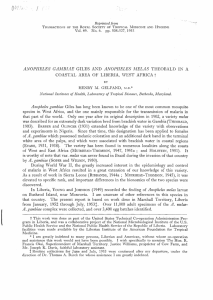Vector Biology and the Control of Malaria in Africa
advertisement
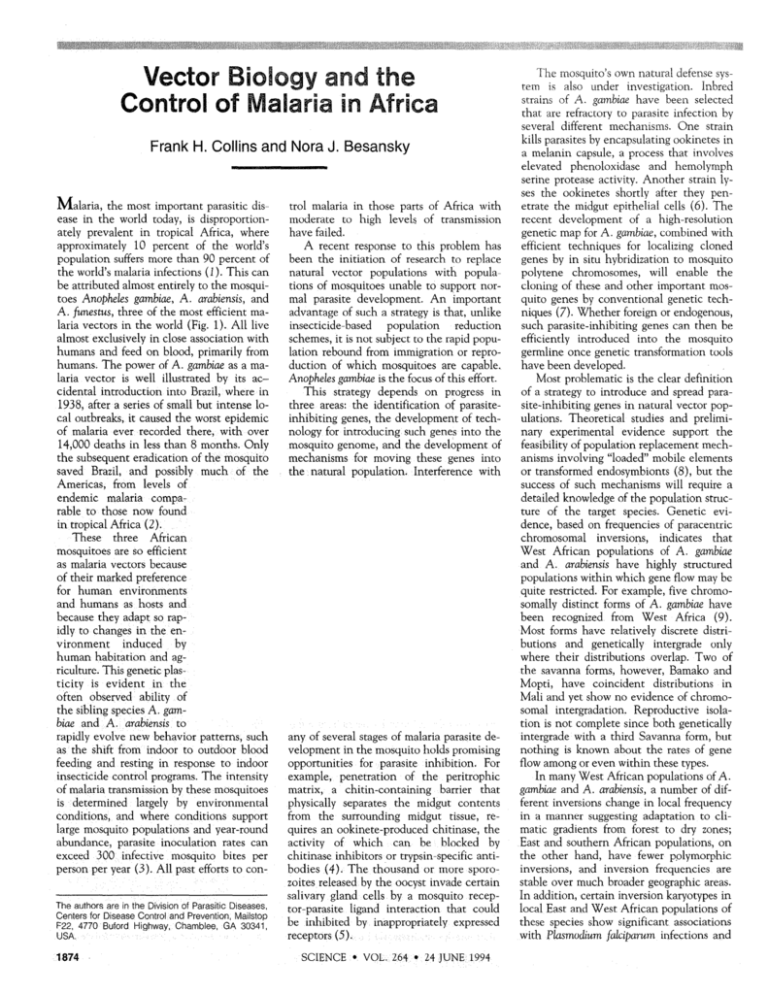
Vector Biology and the Control of Malaria in Africa Frank H. Collins and Nora J. Besansky Malaria, the most important parasitic distrol malaria in those parts of Africa with ease in the world today, is disproportionmoderate to high levels of transmission ately prevalent in tropical Africa, where have failed. approximately 10 percent of the world's A recent response to this problem has population suffers more than 90 percent of been the initiation of research to replace the world's malaria infections (1). This can natural vector populations with popula be attributed almost entirely to the mosquitions of mosquitoes unable to support nortoes Anopheles gambiae, A. arabiensis, and mal parasite development. An important A. funestus, three of the most efficient maadvantage of such a strategy is that, unlike laria vectors in the world (Fig. 1). All live insecticide-based population reduction almost exclusively in close associanon with schemes, it is not subject to the rapid popuhumans and feed on blood, primarily from lation rebound from immigranon or reprohumans. The power of A. gambiae as a maduction of which mosquitoes are capable. laria vector ts well illustrated by its acAnopheles gambiae is the focus of this effort. cidental introduction into Brazil, where m This strategy depends on progress in 1938, after a series of small but intense lothree areas: the identification of parasitecal outbreaks, it caused the worst epidemic inhibiting genes, the development of techof malaria ever recorded there, with over nology for introducing such genes into the 14,000 deaths in less than 8 months. Only mosquito genome, and the development of the subsequent eradication of the mosquito mechanisms for moving these genes into saved Brazil, and possibly much of the the natural population. Interference with Americas, from levels of endemic malaria comparable to those now found in tropical Africa (2). These three African mosquitoes are so efficient as malaria vectors because of their marked preference for human environments and humans as hosts and because they adapt so rapidly to changes in the environment induced by human habitation and agriculture. This genetic plasticity is evident in the often observed ability of Fig. 1. BIood4eeding Anopheles gambiae. [Photograph by ,Jim the sibling species A. gam- Gathany, C D C Photoservices] biae and A. arabiensis t o rapidly evolve new behavior patterns, such any of several stages of malaria parasite deas the shift from indoor to outdoor blood velopment in the mosquito holds prornising feeding and resting in response to indoor opportunities for parasite inhibition. For insecticide control programs. The intensity example, penetration of the peritrophic of malaria transmission by these mosquitoes matrix, a chitin-containing barrier that is determined largely by environmental physically separates the midgut contents conditions, and where conditions support from the surrounding midgut tissue, relarge mosquito populations and year-round quires an ookinete-produced chitinase, the abundance, parasite inoculation rates can activity of which can be blocked by exceed 300 infective mosquito bites per chitinase inhibitors or trypsin-specific antiperson per year (3). All past efforts to conbodies (4). The thousand or more sporozoites released by the oocyst invade certain salivary gland cells by a mosquito recepThe authors are in me Division of Parasitic Diseases. tor-parasite ligand interaction that could Centers for Disease Control and Prevention, Mailstop be inhibited by inappropriately expressed F22 4770 Buford Highway, Chamblee, GA 30341. USA, receptors (5). 1874 SCIENCE • VOL. 264 • 24 JUNE 1994 The mosquito's own natural defense system is also under investigation. Inbred strains of A. gambiae have been selected that are refractory to parasite infection by several different mechanisms. One strain kills parasites by encapsulating ookinetes in a melanin capsule, a process that involves elevated phenoloxidase and hemolymph serine protease activity. Another strain lyses the ookinetes shortly after they penetrate the midgut epithelial cells (6). The recent development of a high-resolution genetic map for A. gambiae, combined with efficient techniques for localizing cloned genes by in situ hybridization to mosquito polytene chromosomes, will enable the cloning of these and other important mosquito genes by conventional genetic techniques (7). Whether foreign or endogenous, such parasite-inhibiting genes can then be efficiently introduced into the mosqmto germline once genetic transformation tools have been developed. Most problematic is the clear definition of a strategy to introduce and spread parasiteqnhibiting genes in natural vector populations. Theoretical studies and preliminary experimental evidence support the feasibility of population replacement mechanisms involving "loaded" mobile elements or transformed endosymbionts (8), but the success of such mechanisms will reqmre a detailed knowledge of the population structure of the target species. Genetic evidence, based on frequencies of paracentric chromosomal reversions, indicates that West African populations of A. gambiae and A. arabiensis have highly structured populations within which gene flow may be quite restricted. For example, five chromosomaliy distinct forms of A. gambiae have been recognized from West Africa (9). Most forms have relatively discrete distributions and genetically intergrade only where their distributions overlap. Two of the savanna forms, however, Bamako and Mopti, have coincident distributions m Mall and yet show no evidence of chromosomal intergradation. Reproductive isolation is not complete since both genetically intergrade with a third Savanna form, but nothing is known about the rates of gene flow among or even within these types. In many West African populations of A. gambiae and A arabiensis, a number of different inversions change in local frequency in a manner suggesting adaptation to climaim gradients from forest to dry zones; East and southern African populations, on the other hand, have fewer polymorphic inversions, and reversion frequencies are stable over much broader geographic areas. In addition, certain inversion karyotypes in local East and West African populations of these species show significant associations with Plasmodium falciparum infections and 4 inversions that have been moved fi'om one the propensity to feed on the blood of hu species to another in laboratory experimans ralher than animals (10). ments. This suggest., that, if a transposable Populations of A. gambiae and A. element or endosvmbiont were used 1o alarabiensis m parts of Africa may experience ter A. gambiae, A. arabiensis would be aflarge reductions and possibly l~ca] extincfected as well at some low but potentially tion., as the weather cycles trom lainy to significant rate. dry seasons. However, even in areas with extremely long dry seasons during which adults are ira-" possible t~ fred, chromosomal inversion frequencies are remarkably stable. Thisl suggests thai either rela -! tively large local populations manage to survive ur/dctected durine such dry seasons (11) or h~cal inver>ion frequencie> arc determined more bv nalur~l] seleclion in, response to eco]oglca] conditi~ns than by dritt during population b,~itlcneck.,. Ckarh/, evidence of reslricted gent flow will change the nature of a control ytrategy based on ge~ netic transformation of an DMsion of Parasitic Diseases] entire species. To date, alControl of malaria in Africa will require most all population genetic studies have been Based on karyotyping of polytene that all major vectors be targeted. Because chromosomes, which can only be scored one of these, A. funestus, is not closely reflom fourth mstar larvae or females with lated to A. gambiae, methods to genetically alter the vectorial capacity of A. gambiae developing ovaries (Fig. 2). The use of genetic markers that can be detecled by the might not be suitable for A. funestus. A single approach should be developed that p~h/merase chain reaction (PCR), m conjunction with cytogenetic data (when would target all three, although the populaavailable), will allow a more comprehenlion biology of A. funestus and its relatives sive examination of the relations among inis not well understood. A. funestus contains version karyotypes, ecological conditions, several polymorphic inversions and it may and mosquito behavior. It will be impo> also be genetically differentiated into lo1an1 1o extend populalion studies 1o other cally adapted populations throughout its locations in Africa, measure popular ion size range in tropical Africa (13). Because this and its spatial and temporal stability, and mosquito breeds in semipermanent bodies define rates of gene flow over a range of of water, there are greater discontinuities in geographic scales. its distribution than that of A. gambiae and Although the genetic structure of popA. arabiensis, which breed in temporary ulations of both A. gambiae and A. arabipools. ]s reduced gene flow associated with ensis would be expected to restrict the these discontinuities? spread of an introduced genetic construct, Another approach is possible. Unlike A. other observations suggest opportunities gambiae and A. arabiensis, A. funestus is for gene flow even between these species. very susceptible to residual insecticides; For example, analysis of mitochondrial and previous residual spray programs have virtunuclear genes in five members of the A. ally eradicated this mosquito fiom large gambiae species complex shows that A. parts of southern Africa. In other areas of gambiae is most closely related to A. Africa where residual spray programs were arabiensis and suggests thai the two species undertaken, numbers of A. funestus quickly may still be experiencing some interspecies declined and recolonization was slow (13). gene flow, at least of mitochondrial DNA If malaria transmission by A. gambiae and (12). ]n fact, chromosornally identified hyA. arabiensis can be eliminated by genetic brids of all sympatric members of the A. means, transmission by A. funestus could gambiae complex have been encountered in perhaps be dealt with by more convennature at frequencies of 0.05 to 0.1 percent, tional technology. and all hybrid females are fertile, some Within the next two decades we will even showing higher fertility than the fesurely see laboratory colonies of A. gambiae male parent. Also, in nature A. gambiae that have been genetically engineered to be and A. arabiensis share some chromosome refractory to P. falciparum, given the pace SCIENCE • VOL. 264 * 24 JUNE 1994 at which recombinant DNA technology and gename mapping lechniques have advanced. To move the vector replacement strategy beyond the laboratory in the same time fl'ame will take a well-executed effort, since success will depend on a continentwide understanding of vector population biology. A transposable element newly introduced into a species could easily spread species-wide within decades, even with restricted gene flow between populations. However, for malaria control, replacement must he accomplished in years rather than decades by mmnerous releases. The strategy for transforming the wild population urgently needs theoretical definition with modeling and with laboratory experiments, a: well as by extensive study of vector populations in the malaria-endemic countries. Rarely voiced is the need for an internati~mal consensus concerning the release of transgenic mosquitoes. What better way to fi>ter a climate of cooperation and trust in the field than by making this effort a truly international collaboration. References 1 J Cattani, D. Davidson, H. Engers. TropicaIDisease Research; Progress 1991-1992 (WHOfTDR Program Report No. 11, 1993). 2 F. L Soper and D. B. Wilson, Anopheles gambiae in Brazil 1930-1940 (Rockefeller Foundation, New York. 1949). 3. J C Be~eretal., J. Med Emomo' 277.570(1990). 4 M. Huber. E Cabib, L H M~lJer.Proc Natl. Acad. SCL U.S.A. 88, 2807 (1991). M Shahabuddin, T. 'loyosh~ma. M. Aikawa, D. C. Kaslow, ibid. 90, 4266 (1993). 5 R Rosenberg, Am. J. 7top. Med. Hyo. 34, 687 (1985); M. G. Touray, A. Warburg, A. Laughinghouse, A. U Krettli, L H. Miller, J. Exp. Med. 175, 1607 (1992). 6 F. H Collins etal.. Science234, 607 (1986); S. M Paskewitz, M R. Brown, F. H. Collins, A. O. Lea, J Parasitol. 75, 594 (1989); S. M. Paskewitz and F H Collins, unpublished data; K.D. Vernick and L H. Miller, unpublished data. 7. L. Zheng, F. H. Collins, V. Kumar, F. C. Kafatos, Science 261,605 (1993); V. Kumar and F. H. Collins, InsectMol. Biol. 3, 41 (1994). 8 M G Kidwell and J. M. C. Ribeiro, Parasitol. Today 8, 325 (1992); J. M C. Ribeiro and M. G. Kidwell, J. Med. EntomoL 31, 10 (1994); G. A. Melster and T. A Grigliatti, Genome 36, 1169 (1993); H R. Braig, H. Guzman, R. B. Tesh, S. L O'Neill, Nature 367, 453 (1994). 9 M Coluzzi, V. Petrarca, M A. Di Deco, Bol. Zool. 52, 45 (1985); Y. T. Toure et al., unpublished data. 10 M Coluzzi, A. Sabatini, V. Petrarca, M. A. Di Deco, Nature 266, 832 (1977); V. Petrarca and J. C. Beier, Am. J. Trop. Med. Hyg. 46, 229 (1992). 11 C. E. Taylor, Y. T. Toure, M. Coluzzi, V. Petrarca, , Med. Vet. Entomol. 7, 351 (1993). 1,2 N. J. Besansky et al., Proe. Natl. Acad. ScL U.S.A., in press. 13. M.T. Gillies and B. De Meillon, The Anophelinae of Africa South of the Sahara (The South African Institute for Medical Research, Johannesburg, 1968), pp. 127-152; M. T. Gillies and M. Coetzee, A Supplement to the Anophelinae of Africa South of the Sahara (The South African Institute for Medical Research, Johannesburg, 1987), pp. 78-87. 14 We thank L. H. Miller, M. Coluzzi, J. M. C. Ribeiro, and our colleagues at the Centers for Disease Control for helpful suggestions. 1875
